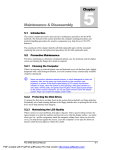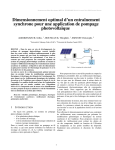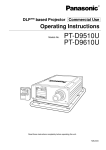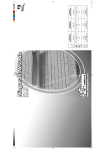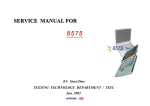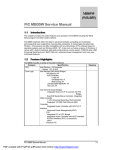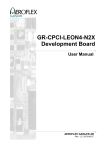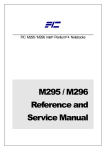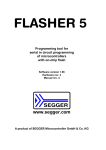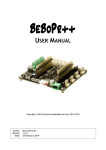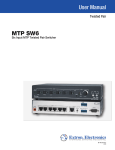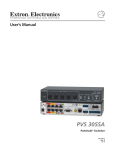Download Software Functional Overview
Transcript
Chapter Software Functional Overview 3.1 Overview The M785 is an IBM PC/AT compatible Notebook PC which supports the Intel uFCPGA Socket Pentium IV processor family. The following are the major features that M785 supports. § Microsoft PC99 logo and WinXP logo approval. § 14.1" XGA / 15.1" XGA, SXGA+ panel support. § APM 1.2 compliance § Support ACPI 1.0B (or above). § Support PCI 2.2 (or above). § Support AGP 2.0. § Support USB 1.1, 2.0 § Support SMBIOS 2.3. § Support 400/533 Mhz CPU front side bus. 3.2 Summary of the BIOS Specification Below is the summary of the BIOS software specification: Controller Chip Description § Microsoft PC99 logo and WinXP logo approval. § Support Boot Block / Crisis Rescue. § APM 1.2 Compliance § Support ACPI 1.0B (or above) Spec. § Support PCI 2.1 (or above) Spec. § Support SMBIOS 2.3 Spec § Support AGP 2.0 Spec. § Support, Windows 2000 and Windows XP. § Support flash function including both DOS and Windows interface for new BIOS update. § Support 2 different keyboards on same BIOS. § Support boot from HDD and CDROM Drive. BIOS Feature CPU Auto detect the CPU type and speed for the Intel Pentium 4 based system DRAM Auto sizing and detection. Support PC-200/266 DDR SDRAM. Cache § Level 2 SRAM auto sizing and detection § Always enable CPU L1 and L2 cache. Shadow Always enable VGA and System BIOS shadow FIC M785 Service Manual PDF created with FinePrint pdfFactory Pro trial version http://www.pdffactory.com 3-1 Software Functional Overview Controller Chip Display Description § § § § Hard Disk System auto detects LCD or CRT presence on boot and lid closed Support Panning while LCD in a display resolution greater than supported Support Microsoft Direct 3D Support AGP 4x BUS § Enhanced IDE spec. § Support auto IDE detection. § Support LBA mode for larger capacity HDD. § Support Ultra DMA 33/66/100. § Support Fast PIO mode 1-4 transfer. § Support 32 bit PIO transfer. § Support Multi-Sector transfer. § Support SMART monitoring. Multi Boot Allow the user to select boot from HDD and CD-ROM Plug and Play Support PnP Run Time Service and conflict-free allocation of resource during POST Smart Battery Support BIOS interface to pass battery information to the application via SMBus. Keyboard Controller Support Fn hot keys, two Windows hot keys, built-in Glide Pad and external PS/2 mouse/keyboard PCMCIA Compliant with PCMCIA 2.1 specification. Power Management Support The power management is compliant with ACPI 1.0B specification and supports the following power state: § S0 (Full-On) Mode § S3 (STR) Mode § S4 (STD) Mode § S5 (Soft-Off) Mode 3-2 FIC M785 Service Manual PDF created with FinePrint pdfFactory Pro trial version http://www.pdffactory.com Software Functional Overview 3.3 Subsystem Software Functions This section provides introduction on the software functions of the notebook subsystems and BIOS related function. 3.3.1 Key Chipset Summary Following are the main chipsets used in the notebook: Controller Chip Vendor Processor North Bridge South Bridge Video Controller PCMCIA Controller Supper I/O Controller Audio Controller Audio Codec Keyboard Controller PMU Controller ROM BIOS IEEE 1394 On board LAN BlueTooth Modem Description Intel SIS SIS SIS ENE DT Pentium 4 (2.0, 2.2, 2.4, 2.6GHz) SIS M650 + SIS 302LV SIS 962 Embedded in SIS M650 CB1410 SMSC LPC47N267 SIS Realtek ENE Embedded in SIS 962 ALC201 ENE KB3886 Mitsubishi SST SIS SIS Not support MDC PMU08 49LF040A Embedded in SIS 962 Embedded in SIS 962 AC'97 S/W Modem 3.3.2 System Memory The system memory consists of SDRAM memory on 64-bit bus and the module size options are 128/256/512MB upward. The BIOS will automatically detect the amount of memory in the system and configure CMOS accordingly during the POST (Power-On Self Test) process. This must be done in a way that requires no user interaction. Base SO-DIMM DRAM slot Base SO-DIMM DRAM slot (Bank 0 & 1) (Bank 2 & 3) NIL NIL NIL 128MB 128MB 128MB 128MB 256MB 512MB NIL 128MB 256MB Total Size 128MB 256MB 512MB 128MB 256MB 384MB FIC M785 Service Manual PDF created with FinePrint pdfFactory Pro trial version http://www.pdffactory.com 3-3 Software Functional Overview 128MB 256MB 256MB 256MB 256MB 512MB 512MB 512MB 512MB 512MB NIL 128MB 256MB 512MB NIL 128MB 256MB 512MB 640MB 256MB 384MB 512MB 768MB 512MB 640MB 768MB 1024MB 3.3.3 Video The Video subsystem used External DDR memory of Video memory. The system will support the true ZV port, the Microsoft Direct 3D assist, simultaneous display, monitor sense for auto display on boot and VESA Super VGA function call. 3.3.4 Supported Video Mode The following is the display modes supported by the SIS Mobility Video control in LCD only, CRT only, and simultaneous mode. The VGA BIOS will allow mode sets of resolutions greater than the panel size but only show as much mode display as will fit on the panel. • Supported Standard VGA Mode The VGA BIOS supports the IBM VGA Standard 7-bit VGA modes numbers. Mode Pixel Resolution Colors Memory 00h/01h 02h/03h 04h/05h 06h 07h 0Dh 0Eh 0Fh 40*25 80*25 320*200 640*200 80*25 320*200 640*200 640*350 16 16 4 2 Mono 16 16 Mono Text Text 2-bit Planar 1-bit Planar Text 4-bit Planar 4-bit Planar 1-bit Planar Mode Pixel Resolution Colors Memory 10h 11h 12h 13h 640*350 640*480 640*480 320*200 16 2 16 256 4-bit Planar 2-bit Planar 4-bit Planar 8-bit Planar Note: All Standard VGA Modes are limited to the standard VGA refresh rates. 3-4 FIC M785 Service Manual PDF created with FinePrint pdfFactory Pro trial version http://www.pdffactory.com Software Functional Overview • Supported extended video modes CRT device will support all listed VESA mode; and other devices such as PANEL & TV may be limited to the mode support due to their characteristics CRT device will support all listed VESA mode; and other devices such as PANEL & TV may be limited to the mode support due to their characteristics. VESA Mode 100h 101h Pixel Resolution 640 x 400 640 x 480 Memory Model 8-bit Packed 8-bit Packed Refresh Rates In (Hz) 70 60, 72, 75, 85 Minimm Memory 2MB 2MB 102h 103h 800 x 600 800 x 600 4-bit Planar 8-bit Packed 60, 72, 75, 85, 100 60, 72, 75, 85, 100 2MB 2MB 104h 1024 x 768 4-bit Planar 2MB 105h 1024 x 768 8-bit Packed 106h 1280 x 1024 4-bit Planar 43(I), 60, 70, 75, 85, 100 43(I), 60, 70, 75, 85, 100 43(I), 60, 75, 85 107h 10Eh 10Fh 1280 x 1024 8-bit Packed 43(I), 60, 75, 85 320 x 200 16-bit Packed 70 320 x 200 32-bit Unpacked 70 111h 112h 640 x 480 640 x 480 114h 115h 117h 800 x 600 800 x 600 1024 x 768 16-bit Packed 60, 72, 75, 85 32-bit Unpacked 60, 72, 75, 85 2MB 2MB 2MB 2MB 2MB 2MB 2MB 2MB 2MB 2MB 11Ah 16-bit Packed 60, 72, 75, 85, 100 32-bit Unpacked 60, 72, 75, 85, 100 16-bit Packed 43(I), 60, 70, 75, 85, 100 1028 x 768 32-bit Unpacked 43(I), 60, 70, 75, 85, 100 1280 x 1024 16-bit Packed 43(I), 60, 75, 85 11Bh 11Dh 11Eh 1280 x 1024 32-bit Unpacked 43(I), 60, 75, 85 640 x 400 16-bit Packed 70 640 x 400 32-bit Packed 70 8MB 2MB 2MB 120h 122h 1600 x 1200 1600 x 1200 2MB 4MB 124h 12Ah 12Bh 1600 x 1200 32-bit Unpacked 48(I), 60, 75, 85 640 x 480 24-bit Packed 60, 72, 75, 85 800 x 600 24-bit Packed 60, 72, 75, 85, 100 118h 8-bit Packed 16-bit Packed 48(I), 60, 75, 85 48(I), 60, 75, 85 4MB 4MB 8MB 2MB 2MB FIC M785 Service Manual PDF created with FinePrint pdfFactory Pro trial version http://www.pdffactory.com 3-5 Software Functional Overview VESA Mode 12Ch Pixel Resolution 1024 x 768 Memory Model 12Dh 12Eh 1280 x 1024 320 x 200 24-bit Packed 8-bit Packed Refresh Rates In (Hz) 43(I), 60, 70, 75, 85, 100 43(I), 60, 75, 85 70 131h 133h 320 x 200 320 x 200 8-bit Packed 16-bit Packed 72 72 2MB 2MB 134h 13Bh* 13Ch* 320 x 200 1400 x 1050 1400 x 1050 32-bit Packed 8-bit Packed 16-bit Packed 72 60, 75 60, 75 2MB 2MB 4MB 13Eh* 141h 1400 x 1050 400 x 300 32-bitUnpacked 60, 75 8-bit Packed 72 8MB 2MB 143h 144h 400 x 300 400 x 300 16-bit Packed 72 32-bitUnpacked 72 2MB 2MB 151h 153h 154h 512 x 384 512 x 384 512 x 384 8-bit Packed 70 16-bit Packed 70 32-bitUnpacked 70 2MB 2MB 2MB 171h 173h 720 x 480 720 x 480 174h 175h 176h 178h 179h 17Ah 24-bit Packed Minimum Memory 4MB 4MB 2MB 75 75 2MB 2MB 720 x 480 720 x 480 720 x 576 24-bit Packed 75 32-bitUnpacked 75 8-bit Packed 75 2MB 2MB 2MB 720 x 576 720 x 576 720 x 576 16-bit Packed 75 24-bit Packed 75 32-bitUnpacked 75 2MB 2MB 2MB 8-bit Packed 16-bit Packed Note: “*” The modes may not be available. Their availability should be determined by VESA function calls. Panel Type Initialization The VGA BIOS will issue INT 15h function call during POST. This function call allows the system BIOS to specify the panel type to the VGA BIOS. The system BIOS should get the panel type from GPI pins before the VGA chip initialized, and pass this information to VGA BIOS through INT 15 Function code. l − 3-6 LCD Panel ID pin Definition: FIC M785 Service Manual PDF created with FinePrint pdfFactory Pro trial version http://www.pdffactory.com Software Functional Overview GPI[45] GPI[46] GPI[10] GPI[22] 0 0 0 0 0 0 0 0 1 1 1 1 1 1 1 1 0 0 0 0 1 1 1 1 0 0 0 0 1 1 1 1 0 0 1 1 0 0 1 1 0 0 1 1 0 0 1 1 0 1 0 1 0 1 0 1 0 1 0 1 0 1 0 1 Panel Type LTN141X8-L04 (Samsung) B141XN04V2 (AU) LTN150U1-L02 (Samsung) LTN150P3-L04 (Samsung) 3.3.5 Enhanced IDE The system BIOS must be ready to support 4 IDE devises on two controllers. The BIOS support Ultra DMA33/66/100 and also supports automatic configuration of drives using both the LBA and CHS large drive remapping method. In addition to supporting standard drives through an auto-configuration process that does NOT require user involvement or confirmation. The system should automatically do this at POST time in a way that is transparent to the user. If a drive is connected to the bus, the drive should be automatically recognized, configured and available for use under MS-DOS 6.2x. 3.3.6 Audio The audio subsystem will support the requirements identified by the AC’97 specification. Both software and hardware will control the volume level for the internal audio subsystem. In addition to the volume control, the user will be able to mute the sound to completely cut off the volume using both software and hardware. 3.3.6 Super I/O This controller contains 16550A or FIFO Enabled UART, ECP/Standard/Bi-directional Parallel Port meeting the 1284 specification, and an Infrared port that supports IrDA Super IR (4Mbps) FIC M785 Service Manual PDF created with FinePrint pdfFactory Pro trial version http://www.pdffactory.com 3-7 Software Functional Overview 3.3.7 PCMCIA The PCMCIA controller chip of the notebook provides the following features: • • • 3.3.8 Support for only single CardBus slot (two type II stacked) Individually accessed, dual-buffer implementation Support for 3.3v, 5v and 12v (flash programming) cards LED Indicator The table below lists down the functions of the Status LED indicator: Indicator Function Description IDE accessing LEDŒ This LED will turn on while accessing the IDE Device. FDD accessing LEDŒ This LED will turn on while accessing the FDD Device. (M785 No support) CapsLock LEDŒ Turn on (Amber) – Battery is under charging mode Turn off – Battery full charged or no battery This LED will turn on when the function of CapsLock is active. ScrollLock LEDŒ This LED will turn on when the function of ScrollLock is active. NumLock LEDŒ Power Status LED This LED will turn on when the function of NumLock is active. Green – System is powered on. Green Blinking- System is entered suspend mode. Amber – Battery Low. Mail LEDŒ GPRS statusŒ This LED will turn on while Mail was arrived. None Battery Charging LED i Œ - There LEDs will be turned off during Suspend mode. 3.3.9 Hot Keys Definition All Hot keys must be active at all times under all operation systems. l Hot Keys by Internal Keyboard Hot Key Fn + F3 3-8 Fn + F4 Fn + F6 Fn + F8 Fn + F9 ScrLock Internet Button Function Toggle Display (LCD/CRT/LCD&CRT) System entered into standby mode System Speaker On/Off Brightness Increase Brightness Decrease Scroll Lock Internet Function Key Mail Button Mail Function Key Handler BIOS Handler BIOS Handler BIOS Handler Controlled by PMU08 Controlled by PMU08 Controlled by Driver Controlled by Driver FIC M785 Service Manual PDF created with FinePrint pdfFactory Pro trial version http://www.pdffactory.com Software Functional Overview 3.3.10 Plug & Play The BIOS supports the Plug and Play Specification 1.0A. (Include ESCD) This section describes the device management. The system board devices and its resources are as follows: Device DMA Controller Interrupt Controller System Timer RTC ISA Bus System Speaker System Board PnP Mother Board Keyboard Controller PMU08 Controller Math Coprocessor PS/2 Mouse Video Controller Serial Port ECP, Parallel port Connect Type Static Static Static Static Static Static Static Static Static Static Static Enable / Disable Static Static Static Dynamic Dynamic FDC Dual IDE Controller Static CardBus Controller Audio chip Static Dynamic IEEE1394 Modem LAN SIR Dynamic USB Host Controller Dynamic Dynamic Dynamic Enable / Disable I/O Resources IRQ DMA Memory 00~0F, 81~8F 20~21, A0~A1 40~43 70~71 61 80 60, 64 IRQ2 IRQ0 IRQ8 IRQ1 DMA4 - E0000~FFFFF - 68, 6C F0~FF - IRQ13 IRQ12 - - 3B0~3BB, 3C0~3DF 3F8~3FF 378~37F, 778~77F 3F0~3F5, 3F7 170~177, 1F0~1F7, 3F6 3E0~3E1 220~22F, 300~301, 388~38B IRQ5 - IRQ4 IRQ7 DMA1 A0000~BFFFF, C0000~CFFFF - 3E8~3EF 1080~10FF 158~15F, 2F82FF EF80~EF9F IRQ6 DMA2 IRQ14, 15 IRQ11 IRQ5 DMA3 - IRQ11 IRQ10 IRQ10 IRQ3 - - IRQ5 - - FIC M785 Service Manual PDF created with FinePrint pdfFactory Pro trial version http://www.pdffactory.com 3-9 Software Functional Overview • PCI Device The table below summarizes the PCI IDSEL Pin Allocation: PCI Device Device Number Function Number AD11 Device 00 Function 0 SISM650 - Host to PCI bridge AD12 Device 01 Function 0 SIS962 – PCI to PCI bridge AD13 Device 02 Function 0 SIS962 - PCI to ISA bridge Function 2 SIS962 - ADSL (Not support) Function 3 SIS962 - 1394 Function 4 SIS962 - PMU and SMBus interface Function 5 SIS962 - IDE interface Function 6 SIS962 - AC97 Modem interface Function 7 SIS962 - AC97 Audio interface Function 0 SIS962 - USB0 Function 1 SIS962 - USB1 Function 2 SIS962 - USB2 Function 3 SIS962 - USB3 IDSEL Pin AD14 Device 03 Device Name AD15 Device 04 Function 0 SIS962 - LAN AD23 Device 0C Function 0 ENE1410 - Card Bus Socket A The table below summarizes the INT Pin Allocation: INT Pin INTA PCI Device INTB 1394/SMB INTC VGA (Embedded in SISM650)/Audio INTD USB (Embedded in SIS962)/LAN IDE/ The table below summarizes the PCI bus master Allocation: Arbiter SIS 962 3-10 Signal Agents (Master) Function REQ00/GNT00 SIS962 LAN Controller REQ10/GNT10 REQ20/GNT20 REQ30/GNT30 REQ40/GNT40 CB1410 MDC SIS962 None Card Bus Controller MODEM Controller 1394 controller None Use FIC M785 Service Manual PDF created with FinePrint pdfFactory Pro trial version http://www.pdffactory.com Software Functional Overview 3.3.11 MBus Devices The SMBus is a two-wire interface through which the system can communicate with powerrelated chips. The BIOS should initialize the SMBus devices during POST. SIS961 SMBus Connection Devices SMBus Device Master/Slave Address BIOS Need to Initialization SIS650 – Core Logic Both Host and Slave 02h Enable SMBus interface and SMBus interrupt SO-DIMM Slave A0h Not Need ICS952001, ICS93722 Slave D2h Program the desired clock frequency (Pin23 output 24MHz, Pin22 output 48MHz) CLK Generator PMU 08 SMBus Connection Devices SMBus Device Host/Slave Address BIOS Need to Initialization A7 ~ A1 PMU08 Master 10h Enable PS01 decode interface MAX1617 (Thermal sensor) Slave 9Ch Program the desired temperature range Battery (1st Battery) Slave A8h No Need 3.3.12 Resource Allocation This section summarizes the resource allocation of the notebook computer. l I/O Map Hex Address 000 - 01F 020 - 021 022 040 - 05F 060 - 064 068 – 06C 070 - 07F 080 - 08F 092 0A0 - 0A1 0B2 0B3 Device 8237-1 8259-1 SIS 962 8254 Keyboard Controller PMU08 Controller RTC & NMI Mask DMA Page Registers System Control Port 8259-2 Advanced Power Management Control Port Advanced Power Management Status Port FIC M785 Service Manual PDF created with FinePrint pdfFactory Pro trial version http://www.pdffactory.com 3-11 Software Functional Overview Hex Address 0C0 – 0DF 8237-2 0F0 – 0FF Math Coprocessor 170 – 177 Secondary IDE Controller 1F0 – 1F7 Primary IDE Controller 200 – 20F Game Port 220 – 22F Sound Blaster 279 MIDI 370 – 371 Sound chip control port 378 – 37A Parallel Port 388 – 38B FM Synthesizer 398 – 399 Super I/O Chip 3B0 – 3DF Video Controller 3E0 – 3E1 PCMCIA Controller 3E8 – 3EF Fax/Modem 3F0 – 3F7 Floppy Disk Controller 3F8 – 3FF Serial Port 1 530 – 537 Microsoft Sound System 778 – 77B ECP port CF8 – CFC DMA 0 DMA 1 DMA 2 DMA 3 DMA 4 DMA 5 DMA 6 DMA 7 PCI BUS configuration register Device Unused ECP Floppy Disk Audio [Cascade] Unused Unused Unused Memory Map Address Range 00000 ~ 9FBFFh 9FC00 ~ 9FFFFh A0000 ~ BFFFFh C0000 ~ CFFFFh 3-12 PnP configuration – Write data port ISA DMA Map DMA Channel l PnP configuration – Address port 330 – 333 A79 l Device Length 640 KB 128 KB 40 KB 72 KB Description System Memory Video Memory Video ROM Unused FIC M785 Service Manual PDF created with FinePrint pdfFactory Pro trial version http://www.pdffactory.com Software Functional Overview D0000 ~ DFFFFh E0000 ~ FFFFFh l 16 KB 128 KB DMI information System ROM BIOS IRQ Map IRQ# IRQ 0 Description System Timer Keyboard [Cascade] PHS (Serial) Serial Port Audio/VGA/USB Floppy Disk Drive Parallel Port RTC Alarm Reserved for PCMCIA card LAN / Modem or Combo, (Card Bus), IEEE 1394 ACPI PS/2 Mouse FPU (FERR) Hard Disk Drive CD-ROM or DVD-ROM IRQ 1 IRQ 2 IRQ 3 IRQ 4 IRQ 5 IRQ 6 IRQ 7 IRQ 8 IRQ 9 IRQ10 IRQ11 IRQ12 IRQ13 IRQ14 IRQ15 3.4 GPIO Pin Assignment The GPI and GPO pins connected to system devices. The BIOS can get device’s status and control the device via the GPI and GPO pins. • SiS650 GPI pin assignment GPIO Number GPIO0 Signal Name Default I/O LPC_PME0 1 I GPIO1 PMUFLASH0 1 O GPIO2 MB_ID0 1 I GPIO3 Q_SMI0 1 I GPIO4 N.C. -- -- GPIO5 N.C GPIO6 N.C. Notes 0 : LPC_PME0 Event Enable 1 : normal operation 0 : Flash PMU08 firmware 1 : normal operation 0 : Mother Board ID0 Select 1 : normal operation 0 : External K/B SMI0 1 : normal operation --- -- -- -- FIC M785 Service Manual PDF created with FinePrint pdfFactory Pro trial version http://www.pdffactory.com 3-13 Software Functional Overview GPIO Number GPIO7 Default I/O EC_SCI0 1 I GPIO8 PM_RI0 1 I GPIO9 GPIO10 N.C. MB_ID1 -1 -I GPIO11 PM_SLP_S10 1 O GPIO12 STPCPU0 1 O GPIO13 GPIO14 GPIO15 N.C. SPDMUX0 N.C. -1 -- O -- 0 : PMU SCI Detect 1 : PMU SCI Not Detect 0 : wakeup event input enable 1 : wakeup event input disable -0 : Mother Board ID1 Select 1 : normal operation 0 : When system into S1 1 : normal operation 0 : Stop CPU Clock 1 : normal operation -SM BUS Select0 -- GPIO16 GPO17 GPIO18 N.C. N.C. SPDMUX1 --1 --O --SM BUS Select1 GPIO19 ICH_SMBCLK 1 O SM BUS Clock GPIO20 ICH_SMBDATA 1 I/O SM BUS Data 3.4.1 PIN GPIOA0 Signal Name PMU08 GPIO Signal Description Signal LID# GPIOA1 N.C. GPIOA2 Mail LED# I/O I X O GPIOA3 QGSMI# I GPIOA4 PCMUTE# O GPIOA5 PSTMSK# O GPIOA6 PCMRI# RI1# N.C. N.C N.C. PDCOM# N.C. I I X X X O X GPIOA7 GPIOB0 GPIOB1 GPIOB2 GPIOB3 GPIOB4 3-14 -- Notes Normal Runtime / Wake event LID Switch Low = LCD Close. Mail LED ENE KB3886 Low = Mail Arrival Low = Keyboard SMI CB1410 Serial Port Low = Mute PC speaker Low = PCI Reset Mask, Hi = PCI Reset Enable Low = Ring Signal from PCMCIA Low = Ring Signal from Serial Port MAX3243 Low = Power down RS232 FIC M785 Service Manual PDF created with FinePrint pdfFactory Pro trial version http://www.pdffactory.com Software Functional Overview PIN Signal I/O GPIOB5 N.C. PM_SLP_S 1# PM_RI# N.C. N.C. CHGLED N.C. X GPIOB6 GPIOB7 GPIOC0 GPIOC1 GPIOC2 GPIOC3 Normal I SIS962 O X X O X SIS962 Runtime / Wake event Low = POS, STR and STD suspend state Low = Wake Up Event (SMI or SCI) Charge LED High = Turn ON Charge LED I : INPUT O : OUTPUT L-Lever : Low Lever H-Lever : Hi Lever Function Pin Description : A : A-D Converter Input Pin 3.4.2 M3886 GPIO Signal Description Address 0060h 0060h 0064h 0064h Bit 7:0 7:0 7:0 7:0 r/w r w r w Description Read Data from Output Data Bus Buffer Write Data to into Input Data Bus Buffer Status Write Command into Input Data Bus Buffer Remark Port Assign: Port PORT 0 PORT 1 PORT 3 PORT 2 PORT 4 Pin Name P07 : P00 P17 : P10 P37 : P30 P27 P26 P25 P24 P23 P22 P21 P20 P46 P45 P44 P43 P42 P41 P40 In/Out OUT OUT IN OUT OUT OUT OUT OUT OUT IN OUT OUT OUT OUT OUT OUT OUT OUT Description Key Scan Data Output Key Scan Data Output Key Scan Data Input SCROLL Lock LED NUM Lock LED CAPS Lock LED BLEN1 Wireless_RFON NC PULL DOWN 1K ohm NC NC PULL UP 10Kohm PULL UP 10Kohm IRQ12 IRQ1 NC KBCSMI0 FIC M785 Service Manual PDF created with FinePrint pdfFactory Pro trial version http://www.pdffactory.com 3-15 Software Functional Overview Port PORT 5 PORT 6 PORT 7 i 3-16 Pin Name P57 P56 P55 P54 In/Out OUT OUT IN IN Description NC NC GPRS_PWRENA GPRS_VDDPD P50 P61 P60 P62 P63 P64 P65 P66 P67 P70 P73 P72 P75 P74 P71 P76 P77 OUT IN IN IN IN OUT IN OUT OUT I/O I/O I/O I/O I/O I/O I/O I/O ISA ADDRESS (SA2) KBSEL2 KBSEL1 GPRS_ON/OFF LOGSEL PASS0 NC BT_FETON1 BT_SENSE0 PS2 DATA PS2 CLOCK EXTERNAL KB DATA EXTERNAL KB CLOCK EXTERNAL MOUSE CLOCK EXTERNAL MOUSE DATA SMDAT_KBC SMCLK_KBC I : INPUT O : OUTPUT FIC M785 Service Manual PDF created with FinePrint pdfFactory Pro trial version http://www.pdffactory.com Software Functional Overview 3.5 Power Management This section provides the Power Management software function of the notebook. 3.5.1 General Requirements The BIOS meet the following general Power Management requirements: • • • • • • • • • • 3.5.2 Compliant with ACPI 1.0B / ACPI 2.0 Specification Support for Suspend-to-RAM and Suspend-to-Disk mode Support for Resume on External Modem Ring while in S3 Mode Support for Resume on Internal Modem Ring while in S3 / S4 Mode Support for LAN Remote Power while in S3 / S4 Mode Power Management must not substantially affect or degrade system performance Power Management must be OS independent Support resume on Time/Date Support Wireless LAN wake up Support Internet / Mail button wake up System Power Plane The system components are grouped as the following parties to let the system to control the On/Off of power under different power management modes. The power plane is divided as following: Power Group Power Control Pin Controlled Devices +B +3VA +12V +5V +3V Nil Nil PWRON PWRON PWRON +5VS SUSB# +3VS SUSB# +RTCVCCS Nil 3.5.3 l IMM, (9V~20V) SIS962 (RTC I/F), Internal Modem Ring, PMU08 PCMCIA Card, AC97 Codec PCMCIA Slot 5V VGA, PCMCIA, PCMCIA Slot 3V, DRAM, Twister(DRAM I/F), ENE KB3886, MAX3243 FLASH ROM, HDD, CD-ROM, USB, Internal K/B, Glide Pad, External P/S2 Mouse, Audio AMP, Fan SIS962 (ISA I/F Power), Clock Generator & Buffer (W137) SIS962 (RTC) Power Management Mode Full On Mode The system state where no devices are power managed and the system can respond to applications with maximum performance. l Doze mode The CPU clock is slow down and all other devices are full-on. FIC M785 Service Manual PDF created with FinePrint pdfFactory Pro trial version http://www.pdffactory.com 3-17 Software Functional Overview l Stand by mode A suspend state where all motherboard components are still powered-on except for the system clock generator device. The PCI and CPU buses are driven to the inactive idle state. The system memory is powered and refreshed by the memory bridge, and the graphics frame buffer is powered and refreshed by the graphic chip. The system provides a 32Khz clock (SUSCLK) in this suspend mode to support refresh of these memory subsystems. Only an enabled “resume event” can bring the system out of the stand by state. The SIS 961 also provides a resume timer that allows the system to resume after a programmed time has elapsed. l Suspend to RAM mode (STR) A suspend state where all motherboard components are powered-off. The CPU/L2 and PCI busses are powered off. All devices connected to the CPU/L2 and PCI busses must either be powered-off or isolate their bus interfaces. The system memory is powered and refreshed by the memory bridge, and the graphics frame buffer is powered and refreshed by the graphics chip. The system provides a 32 kHz clock (SUSCLK) in this suspend mode to support refresh of these memory subsystems. Only an enabled “resume event” can bring the platform out of the suspend to RAM (STR) state. l Suspend to Disk mode (STD) A suspend state where the context of the entire system is saved to disk, all motherboard components are powered-off, and all clocks are stopped. Any enabled “resume event”, such as PowerBTN or RTC, can bring the platform out of the suspend to disk (STD) state. l Soft off mode (SOFF) The This is the same as suspend to disk except the context of memory is not saved. The system will resume from Soft Off as if a hard reset had occurred. l Mechanical off mode All power except the RTC has been removed from the system. 3-18 FIC M785 Service Manual PDF created with FinePrint pdfFactory Pro trial version http://www.pdffactory.com Software Functional Overview 3.5.4 Power Management Mode Transition Flow S1 Sleeping Wake Event SLP_TYPx=S2 and SLP_EN ACPI Boot (SCI_EN=1) G2 (S5) Soft Off G0 (S0) Working SLP_TYPx=S5 and SLP_EN or PWRBTN_OR SLP_TYPx=S1 and SLP_EN S4BIOS_REQ to SMI_CMD OEM S4 BIOS Handler SLP_TYPx=S3 and SLP_EN SLP_TYPx=S4 and SLP_EN S2 Sleeping G1 S3 Sleeping S4 Sleeping SLP_TYPx=S4 and SLP_EN FIC M785 Service Manual PDF created with FinePrint pdfFactory Pro trial version http://www.pdffactory.com 3-19 Software Functional Overview 3.5.5 Power Management Mode Transition Event The following table summarizes the entry events and wake-up events of each power Power State Entry Event Wake up Event S1 OSPM control Power Button Lid Close Ring Indicator Battery Low - Low RTC Alarm LAN Wake Up S4 OSPM control, Power Button STD hot key pressed RTC Alarm Lid Close Battery Low – Low S5 Power Button Power Button Execute Windows shutdown RTC Alarm command 3.5.6 Lid Switch The function of Lid Switch is depends on the ACPI aware OS 3.5.7 Power button and suspend button The function of Lid Switch is depends on the ACPI aware OS. 3.5.8 l Device Power management Power state of local devices table PowerState Component Doze Stand By STR STD/SOff Stop Grant ON ON Stop Clock Power Off Power Off Power Down Stop Clock Power Off Power Off SIS962 ON ON DRAM Clock Synthesizer CDROM HDD FDD (M785 None) KBC ON ON ON ON ON ON Self Refresh Low Power Power Down Power Down Power Down ON Power Off Power Off (except Vcc) Power Off (except SUSVcc, RTCVcc ) Self Refresh Power Off Power Off Power Off Power Off Power Down CPU L2 CACHE SISM650 3-20 Power Off (except SUSVcc, RTCVcc) Power Off Power Off Power Off Power Off Power Off Power Off FIC M785 Service Manual PDF created with FinePrint pdfFactory Pro trial version http://www.pdffactory.com Software Functional Overview PMU08 VGA/VRAM PCMCIA Super I/O AUDIO Audio AMP LCD Backlight Serial Port IR Module LAN Internal Modem l ON ON ON ON ON ON ON ON ON ON ON ON Power Down Power Down Power Down Power Down Power Down Power Off Power Down Power Down Power Down Power Down Power Down Power Down Power Down Power Off Power Off Power Off Power Off Power Down Power Off Power Down Power Down Power Down Power Off Power Off Power Off Power Off Power Off Power Off Power Off Power Off Power Down Power Down Device PM control during Stand By mode Device Power Controlled by Description CPU L2 CACHE SISM650 SIS962 DRAM Clock Synthesizer CDROM HDD FDD (M785 Not support) KBC VGA/VRAM PCMCIA Super I/O AUDIO Audio AMP LCD Backlight Serial Port Hardware Hardware Hardware Working Hardware Hardware Software Software Software Controlled by SUS_STAT1# pin Controlled by BIOS Controlled by SUS_STAT1# pin Self Refresh Controlled by SUSA# pin CDROM support power down command HDD support power down command FDD support power down command Working Software Software Software Software Software Hardware Software Controlled by SISM650 Controlled by Driver enter Dx status Controlled by SIS962 Controlled by SIS962 Controlled by BIOS Controlled by VGA chip Controlled by PMU08 GPIO[B3] pin IR Module Software IR module support power down command LAN Software LAN support power down command Internal Modem Software Modem support power down command FIC M785 Service Manual PDF created with FinePrint pdfFactory Pro trial version http://www.pdffactory.com 3-21 Software Functional Overview l Device PM control during STR mode Device Power Down Controlled by Description CPU L2 CACHE SIS962 DRAM Clock Synthesizer CDROM HDD FDD (M785 Not support) KBC Hardware Hardware Hardware Software Hardware Hardware Hardware Hardware Controlled by SUSB# pin Power off Controlled by SUSB# pin Self Refresh Controlled by SUSB# pin Power off Power off Power off Software PMU08 VGA/VRAM PCMCIA Super I/O AUDIO Audio AMP LCD Backlight Serial Port IR Module LAN Sofeware Software Software Hardware Hardware Hardware Hardware Software Hardware Hardware Controlled by ENE KB3886 power down command Controlled by PMU08 power down command Controlled by SISM650 Controlled by SUSB# pin Controlled by SIS962 Controlled by SIS962 Controlled by BIOS Power off Controlled by PMU08 GPIO[B3] pin Controlled by SUSB# pin Controlled by Driver enter Dx status Internal Modem Hardware Controlled by Driver enter Dx ststus 3-22 FIC M785 Service Manual PDF created with FinePrint pdfFactory Pro trial version http://www.pdffactory.com Software Functional Overview 3.6.1 Expanding Event Through the Embedded Controller The following figure shows the relationships between the devices that are wired to the embedded controller, the embedded controller queries, and ACPI general FIC M785 Service Manual PDF created with FinePrint pdfFactory Pro trial version http://www.pdffactory.com 3-23 Software Functional Overview l SCI Source and Query Event from M38867 PMU08 ADPIN# BAT0# GPIOA0 GPIOA3 GPIOA6 GPIOA7 THRM Input Event GPE Event Handler AC Plug In/Out Battery Plug In/Out LID Event Keyboard SMI PCMCIA Ring In COM Port Ring In Thermal Event GPI1 GPI1 RI RI RI RI GPI1 AML Handler AML Handler AML Handler AML Handler AML Handler AML Handler AML Handler The system will issue a beep to inform user while the following SCI alerted: § AC (AC status change) update battery information. § BAT ( Battery status change) update battery information. § Lid § RI10 (Lid close/open event) update Lid position status. COM Port Ring Event § PCMRI10 PCMCIA Ring Event § THRM0 (Thermal event) update thermal level information l Control Method Battery Subsystem EC should support all the battery information to ACPI-OS − Designed Battery capacity − Designed Voltage − Designed Low battery capacity − Designed Low – Low battery capacity − Latest Full charged capacity − Present Remaining capacity − Present drain rate − Present voltage − Present Battery Status ACPI BIOS should support an independent device object in the name space, and implement the following methods. 3-24 FIC M785 Service Manual PDF created with FinePrint pdfFactory Pro trial version http://www.pdffactory.com Software Functional Overview 3.6.2 Thermal Control There are three primary cooling policies that the OS use to control the thermal state of the hardware. Cooling Policy Action cooling Action cooling Action Fan On Fan High On Fan High Off Passive cooling Throttling CPU On Throttling CPU Off Critical trip point System Shutdown Temperature Setting Always On Over 55oC Below 50oC Over 70oC Below 60oC Over 80oC ACPI allows OS to be proactive in its system cooling policies. With OS in control of the operating environment, cooling decisions can be made based on application load on the CPU and the thermal heuristics of the system. Graceful shutdown of OS at critical heat levels becomes possible as well. The following sections describe the thermal objects available to OS to control platform temperature. ACPI expects all temperatures to be given in tenths of Kelvin. The ACPI thermal design is based around regions called thermal zones. Generally, the entire PC is one large thermal zone, but an OEM can partition the system into several thermal zones if necessary. l Active, Passive, and Critical Policies There are three primary cooling policies that the OS uses to control the thermal state of the hardware. The policies are Active, Passive and Critical: − − − Passive cooling: The OS reduces the power consumption of the system to reduce the thermal output of the machine by slowing the processor clock. The _PSV control method is used to declare the temperature to start passive cooling. Active cooling: The OS takes a direct action such as turning on a fan. The _ACx control methods declare the temperatures to start different active cooling levels. Critical trip point: This is the threshold temperature at which the OS performs an orderly, but critical, shut down of the system. The _CRT object declares the critical temperature at which the OS must perform a critical shutdown. When a thermal zone appears, the OS runs control methods to retrieve the three temperature points at which it executes the cooling policy. When the OS receives a thermal SCI it will run the _TMP control method, which returns the current temperature of the thermal zone. The OS checks the current temperature against the thermal event temperatures. If _TMP is greater than or equal to _ACx then the OS will turn on the associated active cooling device(s). If _TMP is greater than or equal to _PSV then the OS will perform CPU throttling. Finally if _TMP is greater than or equal to _CRT then the OS will shutdown the system. An optimally designed system that uses several SCI events can notify the OS of thermal increase or decrease by raising an interrupt every several degrees. This enables the OS to FIC M785 Service Manual PDF created with FinePrint pdfFactory Pro trial version http://www.pdffactory.com 3-25 Software Functional Overview anticipate _ACx, PSV, or _CRT events and incorporate heuristics to better manage the systems temperature.The operating system can request that the hardware change the priority of active cooling vs passive cooling. l Dynamically Changing Cooling Temperatures An OEM can reset _ACx and _PSV and notify the OS to reevaluate the control methods to retrieve the new temperature settings. The following three causes are the primary uses for this thermal notification: − − − When a user changes from one cooling mode to the other. When a swappable bay device is inserted or removed. A swappable bay is a slot that can accommodate several different devices that have identical form factors, such as a CD-ROM drive, disk drive, and so on. Many mobile PCs have this concept already in place. When the temperature reaches an _ACx or the _PSV policy settings In each situation, the OEM-provided AML code must execute a Notify ( thermal_zone, 0x80) statement to request the OS to re-evaluate each policy temperature by running the _PSV and _ACx control methods. n Resetting Cooling Temperatures from the User Interface When the user employs the UI to change from one cooling mode to the other, the following occurs: 1. The OS notifies the hardware of the new cooling mode by running the Set Cooling Policy (_SCP) control method. 2. When the hardware receives the notification, it can set a new temperature for both cooling policies and notify the OS that the thermal zone policy temperatures have changed. 3. The OS re-evaluates _PSV and _ACx. n Resetting Cooling Temperatures to Adjust to Bay Device Insertion or Removal The hardware can adjust the thermal zone temperature to accommodate the maximum operating temperature of a bay device as necessary. For example, 1. Hardware detects that a device was inserted into or removed from the bay and resets the _PSV and/or _ACx and then notifies the OS of the thermal and device insertion events. 2. The OS reenumerates the devices and reevaluates _PSV and _ACx. n Resetting Cooling Temperatures to Implement Hysteresis An OEM can build hysteresis into platform thermal design by dynamically resetting cooling temperatures. For example, 3-26 FIC M785 Service Manual PDF created with FinePrint pdfFactory Pro trial version http://www.pdffactory.com Software Functional Overview 1. When the heat increases to the temperature designated by _ACx, the OS will turn on the associated active cooling device and the hardware will reset the ACx value to a lower temperature. 2. The hardware will then run the Notify command and the OS will reevaluate the new temperatures. Because of the lower _ACx value now, the fan will be turned off at a lower temperature than when turned on. 3. When the temperature hits the lower _ACx value, the OS will turn off the fan and reevaluate the control methods when notified. 3.6.3 Hardware Thermal Events An ACPI-compatible OS expects the hardware to generate a thermal event notification through the use of the SCI. When the OS receives the SCI event, it will run the _TMP control method to evaluate the current temperature. Then the OS will compare the value to the cooling policy temperatures. If the temperature has crossed over one of the three policy thresholds, then the OS will actively or passively cool (or stop cooling) the system, or shutdown the system entirely. This is an SCI and you can define how ever many as necessary 90 85 80 75 60 55 50 45 40 35 30 25 20 15 10 5 _CRT _AC0 _AC1 _PSV Method SCI Event Both the number of SCI events to be implemented and the granularity of the temperature separation between each SCI event is OEM-specific. However, it is important to note that since the OS can use heuristic knowledge to help cool the system, the more events the OS receives the better understanding it will have of the system thermal characteristic. 3.6.4 Active Cooling Strength The Active cooling methods (_Acx) in conjunction with active cooling lists (_ALx), allows an OEM to use a device that offers varying degrees of cooling capability or multiple cooling devices. The _ACx method designates the temperature at which the Active cooling is enabled or disabled (depending upon the direction in which the temperature is changing). The _ALx method evaluates to a list of devices that actively cool the zone. For example: • If a standard single-speed fan is the Active cooling device, then the policy is represented by the temperature to which _AC0 evaluates, and the fan is listed in _AL0. FIC M785 Service Manual PDF created with FinePrint pdfFactory Pro trial version http://www.pdffactory.com 3-27 Software Functional Overview • If the zone uses two independently-controlled single-speed fans to regulate the temperature, then _AC0 will evaluate to the maximum cooling temperature using two fans, and _AC1 will evaluate to the standard cooling temperature using one fan. If a zone has a single fan with a low speed and a high speed, the _AC0 will evaluate to the temperature associated with running the fan at high-speed, and _AC1 will evaluate to the temperature associated with running the fan at low speed. _AL0 and _AL1 will both point to different device objects associated with the same physical fan, but control the fan at different speeds. • 3.6.5 Passive Cooling Equation 100% Tn - 1 ∆P Tn Tt CPU Performance Temperature Unlike the case for _ACx, during passive cooling the OS takes the initiative to actively monitor the temperature in order to cool the platform. On an ACPI-compatible platform that properly implements CPU throttling, the temperature transitions will be similar to the following figure. _TSP (Sampling period) 50% Time For the OS to assess the optimum CPU performance change required to bring the temperature down, the following equation must be incorporated into the OS. ∆P [%] = _TC1 * ( Tn - Tn-1 ) + _TC2 * (Tn - Tt) where Tn = current temperature Tt = target temperature (_PSV) The two coefficients _TC1 and _TC2 and the sampling period _TSP are hardware-dependent constants the OEM must supply to the OS (for more information, see section 12.3). The object _TSP contains a time interval that the OS uses to poll the hardware to sample the temperature. Whenever _TSP time has elapsed, the OS will run _TMP to sample the current temperature (shown as Tn in the above equation). Then the OS will use the sampled temperature and _PSV (which is the target temperature Tt) to evaluate the equation for ∆P. The granularity of ∆P is determined by the CPU duty width of the system. A detailed explanation of this thermal feedback equation is beyond the scope of this specification. 3-28 FIC M785 Service Manual PDF created with FinePrint pdfFactory Pro trial version http://www.pdffactory.com Software Functional Overview 3.6.6 Critical Shutdown When the heat reaches the temperature indicated by _CRT, the OS must immediately shutdown the system. The system must disable the power either after the temperature reaches some hardware-determined level above _CRT or after a predetermined time has passed. Before disabling power, platform designers should incorporate some time that allows the OS to run its critical shutdown operation. There is no requirement for a minimum shutdown operation window that commences immediately after the temperature reaches _CRT. This is because − − Heat might rise rapidly in some systems and slower on others, depending on casing design and environmental factors. Shutdown can take several minutes on a server and only a few short seconds on a hand-held device. Because of this indistinct discrepancy and the fact that a critical heat situation is a remarkably rare occurrence, ACPI does not specify a target window for a safe shutdown. It is entirely up to the OEM to build in a safe buffer that it sees fit for the target platform. 3.6.7 Other Implementation of Thermal Controllable Devices The ACPI thermal event model is flexible enough to accommodate control of almost any system device capable of controlling heat. For example, if a mobile PC requires the battery charger to reduce the charging rate in order to reduce heat it can be seamlessly implemented as an ACPI cooling device. Associating the charger as an active cooling device and reporting to the OS target temperatures that will enable or disable the power resource to the device do this. Figure as following illustrates the implementation. Because the example does not create noise, this will be an implementation of silence mode. 90 85 80 75 60 _CRT 55 50 45 40 35 30 25 20 15 10 _AC0 Fan on/off _PSV Throttle CPU _AC1 Reduce charge rate 5 FIC M785 Service Manual PDF created with FinePrint pdfFactory Pro trial version http://www.pdffactory.com 3-29 Software Functional Overview 3.6.8 Thermal Control Methods Control methods and objects related to thermal management are listed in the table below. Object Description _ACx Returns Active trip point in tenths Kelvin _ALx List of pointers to active cooling device objects _CRT Returns critical trip point in tenths Kelvin _PSL List of pointers to passive cooling device objects _PSV Returns Passive trip point in tenths Kelvin _SCP Sets user cooling policy (Active or Passive) _TC1 Thermal constant for Passive cooling _TC2 Thermal constant for Passive cooling _TMP Returns current temperature in tenths Kelvin _TSP Thermal sampling period for Passive cooling in tenths of seconds l _Acx This control method returns the temperature at which the OS must start or stop Active cooling, where x is a value between 0 and 9 that designates multiple active cooling levels of the thermal zone. If the Active cooling device has one cooling level (that is, n”) then that cooling level is named _AC0. If the cooling device has two levels of capability, such as a high fan speed and a low fan speed, then they are named _AC0 and _AC1 respectively. The smaller the value of x, the greater the cooling strength _ACx represents. In the above example, _AC0 represents the greater level of cooling (the faster fan speed) and _AC1 represents the lesser level of cooling (the slower fan speed). For every ACx method, there must be a matching ALx method. Arguments: None. Result Code: Temperature in tenths Kelvin The result code is an integer value that describes up to 0.1 precisions in Kelvin. For example, 300.0K are represented by the integer 3000. l _ALx This object evaluates to a list of Active cooling devices to be turned on when the associated _ACx trip point is exceeded. For example, these devices could be fans. l _CRT This control method returns the critical temperature at which the OS must shutdown the system. Arguments: None. Result Code: Temperature in tenths Kelvin The result is an integer value that describes up to 0.1 precisions in Kelvin. For example, 3-30 FIC M785 Service Manual PDF created with FinePrint pdfFactory Pro trial version http://www.pdffactory.com Software Functional Overview 300.0K are represented by the integer 3000. l _PSL This object evaluates to a list of processor objects to be used for Passive cooling. l _PSV This control method returns the temperature at which the OS must activate CPU throttling. Arguments: None. Result Code: Temperature in tenths Kelvin. The result code is an integer value that describes up to 0.1 precision in Kelvin. For example, 300.0 Kelvin is represented by 3000. l _SCP This control method notifies the hardware of the current user cooling mode setting. The hardware can use this as a trigger to reassign _ACx and _PSV temperatures. The operating system will automatically evaluate _ACx and _PSV objects after executing _SCP. Arguments: 0 - Active; 1 - Passive Result Code: None. l _TC1 This is a thermal object that evaluates to the constant _ TC1 for use in the Passive cooling formula: ∆Performance [%]= _TC2 * ( Tn - Tn-1 ) + _TC1 * (Tn. - Tt) l _TC2 This is a thermal object that evaluates to the constant _TC2 for use in the Passive cooling formula: ∆Performance [%]= _TC2 * ( Tn - Tn-1 ) + _TC1 *.(Tn. - Tt) l _TMP This control method returns the thermal zone current operating temperature in Kelvin. Argument: None. Result Code: Temperature in tenths Kelvin. The result is an integer value that describes up to 0.1 precision in Kelvin. For example, 300.0K is represented by the integer 3000. l _TSP This is an object that evaluates to a thermal sampling period used by the OS to implement the Passive cooling equation. This value, along with _TC1 and _TC2, will enable the OS to provide the proper hysteresis required by the system to accomplish an effective passive cooling policy. The granularity of the sampling period is 0.1second. For example, if the sampling period is 30.0 seconds, then _TSP needs to report 300; if the sampling period is 0.5 seconds, then it will report 5. The OS can normalize the sampling over a longer period if necessary. FIC M785 Service Manual PDF created with FinePrint pdfFactory Pro trial version http://www.pdffactory.com 3-31 Software Functional Overview 3.6.9 AC Adapters and Power Source Objects The Power Source objects describe the power source used to run the system. Object Description _PSR Returns present power source device _PCL List of pointers to powered devices. l _PSR Returns the current power source devices. Used for the AC adapter and is located under the AC adapter object in name space. Used to determine if system is running off the AC adapter. Arguments: None Results code: 0x00000000 = Off-line; 0x00000001 = On-line l _PCL This object evaluates to a list of pointers, each pointing to a device or a bus powered by the power source device. Pointing a bus means that all devices under the bus is powered by it power source device. 3.7 Battery Management This notebook supports only Li-Ion Battery Pack. There is only one battery pack activating at one time. The special designed Bridge Battery module can backup the system under Suspend To RAM mode for a short period of time. 3.7.1 Battery Sub-system § The charger will stop charge the battery when the following condition is detected. - The temperature of the system is too high - The remaining capacity is 95% and more. Note that the battery life is depend on different configuration running. E.g. with CD-ROM battery life is shorter, document keyin only battery life is longer, PMU disable battery life is short, PMU enable battery life is longer. - Battery reading methodology is through PMU08 SMBus. - 3.7.2 Battery Low Warning When the battery voltage is approaching to the Low level, the PMU08 will generate a battery low SMI. The system will do the following action. 1) The Power Indicator will become blinking. 2) The system will issue a Warning beep. 3.7.3 Battery Low When the battery voltage is approaching to the Low-Low level, the PMU08 will generate a battery low-low SMI. The system will do the following action. 1) The Power Indicator will keep on Blinking. 2) The system will enter Suspend To Disk mode even the power management is disabled. The function of power-on or Resume will be inhibited until the battery Low – Low condition is removed. 3-32 FIC M785 Service Manual PDF created with FinePrint pdfFactory Pro trial version http://www.pdffactory.com Software Functional Overview 3.7.4 AC Adapter When plug in the AC adapter, the system will do the following action: - The charger will charge the Main Battery, if remaining capacity is not full. - The Battery Charging Indicator will turn on if the battery is in changing mode. 3.8 PMU08 The embedded controller PMU08 acts as a supplement for power management control. It supports a lot of functions via SMBus interface. 3.8.1 The System EC RAM With PMU08 Embedded Controller Command Set The EC I/F command set allows the OS to communicate with the PMU08. For detail information refer to ACPI 1.0B specification. Command EC I/F Command Byte Byte Register #1 EC_SC #2 EC_DA TA EC_DA TA EC_SC R / W Description Interrupt Encoding Read Embedded Controller (RD_EC) 0x80 #3 Write Embedded Controller (WR_EC) 0x81 #1 #2 #3 Burst Enable Embedded Controller (BE_EC) Burst Disable Embedded Controller (BD_EC) Query Embedded Controller (QR_EC) 3.8.2 0x82 #1 #2 EC_DA TA EC_DA TA EC_SC 0x83 #1 EC_DA TA EC_SC 0x84 #1 EC_SC #2 EC_DA TA W Command byte Header W Address byte to read R Read data to host W Command byte Header W Address byte to write W Data to write W Command byte Header R Burst acknowledge byte W Command byte Header W Command byte Header R Query value to host Interrupt on IBF=0 No Interrupt Interrupt on OBF=1 Interrupt on IBF=0 Interrupt on IBF=0 Interrupt on IBF=0 No Interrupt Interrupt on OBF=1 Interrupt on IBF=0 No Interrupt Interrupt on OBF=1 PMU08 EC RAM List The micro controller PMU08 acts as a supplement for power management control. It supports the following functions via SMBus Command ( 0x80 , 0xC0 ) FIC M785 Service Manual PDF created with FinePrint pdfFactory Pro trial version http://www.pdffactory.com 3-33 Software Functional Overview Function Address 00h *3 02h *3 04h *3 08h *3 Design Voltage Design capacity of Warning Design capacity of Low Battery capacity Granularity 1 Battery capacity Granularity 2 Model number Serial Number 0Eh *3 3-34 Design capacity Last Full Charge Capacity Battery Technology 0Ch *3 *1: *3: R(/W): Power unit 06h *3 0Ah *3 1st Battery [ _BIF ] Register Name 10h *3 12h *3 14h *3 R/W 7 Bit Number Logic Default Description 6 5 4 3 2 1 0 0x0000: mWh [Fixed value] 0xffff: Unknown 0x0000-0xfffe(mWh) 0xffff 0xffff: Unknown R(/W) DATA[15:0] *1 - R(/W) DATA[15:0] *1 - R(/W) DATA[15:0] *1 - R(/W) DATA[15:0] *1 - R(/W) DATA[15:0] *1 - R(/W) DATA[15:0] *1 - 0xffff 0x0000-0xfffe(mWh) 0xffff: Unknown R(/W) DATA[15:0] *1 - 0xffff 0x0000-0xfffe(mWh) 0xffff: Unknown R(/W) DATA[15:0] *1 - 0xffff 0x0000-0xfffe(mWh) 0xffff: Unknown R(/W) DATA[15:0] *1 - 0xffff 0x0000-0xfffe(mWh) 0xffff: Unknown R(/W) DATA[15:0] *1 - 0xffff 0x0000 [Not support] R(/W) DATA[15:0] *1 - 0xffff 0x0000 [Not support] 16h *3 Battery type R(/W) 18h *3 OEM Information R(/W) DATA[15:8] CELL_TYP *1 E All bits are 0 [7:0] DATA [15:8] *1 All bits are 0 Vender[7:0] - - 0xffff 0xffff 0x0000-0xfffe(mWh) 0xffff: Unknown 0x0000 : Primary 0xffff 0x0001: Secondary [Fixed value] 0xffff: Unknown. 0x0000-0xfffe(mV) 0xffff 0xffff: Unknown CELL_TYPE [3:0] This code depends on battery data format. In the future, this code may be added. 0xffff 0x00: NiMH 0x01: Li-ion 0x10: Non-rechargeable battery (Reserved) Vender [7:0] This code depends on battery data format. And the following name should be described in the ASL with the same character code. In the future, these codes will be 0xffff added. 0: “MoliEnergy” 1: “Panasonic” 2: (SANYO does not agree the vender name display) 3: “TBCL” (Toshiba) 4: “Sony” The register type is word. This register is not cleared if the system is in S4-S5 state. This is the read only register, but the written data will be able to read back till PMU updates the data periodically, or PMU detects the status change. FIC M785 Service Manual PDF created with FinePrint pdfFactory Pro trial version http://www.pdffactory.com Software Functional Overview Function Address 1Ah *3 1st Battery [ _BST ] 1Ch *3 1Eh *3 20h *3 1st Battery [ _BTP ] 22h 2nd Battery [ _BIF ] 24h to 3Ch *3 3Eh to 44h *3 2nd Battery [ _BST ] 2nd Battery [ _BTP ] - The battery is discharged DCHG=1: The battery is CHG =1 : charged CRIT =1 : The battery is critical (Empty) 0x0000-0xfffe(mW) 0xffff 0xffff: Unknown - R(/W) DATA[15:0] *1 - R(/W) DATA[15:0] *1 - 0xffff 0x0000-0xfffe(mWh) 0xffff: Unknown R(/W) DATA[15:0] *1 - 0xffff 0x0000-0xfffe(mV) 0xffff: Unknown DATA[15:0] *1 - 0x0000 Battery Trip R/W Point 0x0000 :Clear the trip point 0x0001-0xffff(mWh) *2 *2 *2 *2 *2 *2 *2 *2 *2 *2 46h *2 *2 *2 *2 *2 *2 48h Battery data Size R(/W) DATA[7:0] - - 0x01 : DATA size is 3byte.(PMU06A) 0x00 :DATA size is 2 byte. (PMU06) *8 49h Design capacity R(/W) DATA[23:16] *1 *7 - 0xff PMU06A use this data with 02/03h. *7 *8 R(/W) DATA[23:16] *1 *7 - 0xff PMU06A use this data with 04/05h. *7 *8 R(/W) DATA[23:16] *1 *7 - 0xff PMU06A use this data with 1E/1Fh. *7 *8 R(/W) DATA[23:16] *1 *7 - 0x00 R(/W) DATA[23:16] *1 *7 - 0xff R/(/W) DATA[23:16] *1 *7 - 0xff PMU06A use this data with 28/29h. *7 *8 R(/W) DATA[23:16] *1 *7 - 0xff PMU06A use this data with 42/43h. *7 *8 50h Battery Trip R(/W) Point DATA[23:16] *1 *7 0x00 PMU06A use this data with 46/47h. *7 *8 51h to 6Bh *3 Reserved 1st Battery [_BST] 4Bh 1st Battery [_BTP] 4Ch 4Dh *1: *2: *3: R(/W): Bit Number Logic Default Description 6 5 4 3 2 1 0 D C C C DATA[15:3] *1 R H All bits are 0 I H G T G Battery State R(/W) Battery Present rate Battery Remaining Capacity Battery present Voltage 7 *2 4Ah 2nd Battery [_BST] 2nd Battery [_BTP] R/W *2 1st Battery [_BIF] 2nd Battery [_BIF] Register Name 4Eh 4Fh Last Full Charge Capacity Battery Remaining Capacity Battery Trip Point Design capacity Last Full Charge Capacity Battery Remaing Capacity R/W Don’t care - PMU06A use this data with 22/23h. *7 *8 PMU06A use this data with 26/27h. *7 *8 - The register type is word. Same as 1st Battery CMBatt Data This register is not cleared if the system is in S4-S5 state. This is the read only register, but the written data will be able to read back till PMU updates the data periodically, or PMU detects the status change. FIC M785 Service Manual PDF created with FinePrint pdfFactory Pro trial version http://www.pdffactory.com 3-35 Software Functional Overview Function Address 6Ch PMU Access Reserved *7: R(/W): 3-36 R/W Bit Number Logic Default Description 7 6 5 4 3 2 1 0 R/W DATA [7:0] - - R/W DATA [15:8] - - R/W DATA [7:0] - - 6Fh PMU_DATA R/W DATA [7:0] - - 70h *7 SMB_PTCL R/W PROTOCOL[7:0] - - - - 6Dh 6Eh 71h *7 SMBus Register Name PMU_LOW_ ADR PMU_HIG_ ADR CHECK_ SUM SMB_STS R/W 72h SMB_ADDR R/W 73h SMB_CMD 74h to 93h SMB_DATA R/W [0-31] 94h SMB_BCNT R/W 95h SMB_ ALARM_ ADDR R(/W) 96h to 97h AMB_ ALARM_ DATA[0-1] R(/W) 98h SMB_CNRL R/W 99h to 9Fh Reserved R/W R/W D O N E A R L E R S M STATUS [4:0] ADDRESS [6:0] R E S - - COMMAND - - DATA - - RES[7:5] BCNT[4:0] ADDRESS[6:0] R E S DATA RES[7:1] Don't care - - - - - - P R T 0x00 - These registers are available when PMU slave mode or charger mode is selected. For detail information, refer to PMU slave communication section in this document For detail information, refer to ACPI 1.0 specification [ 13.9 SMBus Host controller Interface via Embedded controller] These registers are not available when PMU slave mode or charger mode is selected. The PMU06 has access protect function for the EEPROM in the battery, to cancel the protection, set the access protect cancel bit. For detail, refer to SMBus section PRT =1 : The SMBus address (A8-AE) protection is cancelled. - When this register is checked by polling, the interval time is necessary more than 500usec. This is the read only register, but the written data will be able to read back till PMU updates the data periodically, or PMU detects the status change. FIC M785 Service Manual PDF created with FinePrint pdfFactory Pro trial version http://www.pdffactory.com Software Functional Overview Function Address R/W A0h *3 ADP_STS A1h *3 BAT1_STS R(/W) (1st Battery) A2h *3 A3h *3 A4h *3 A5h *3 A6h *3 Status Register Name R(/W) Bit Number 7 6 5 4 3 2 1 0 C RES[7:1] O N DeDescription fault - - - - - - Don’t care - - BAT1_CAP R(/W) BCAP - - BAT2_CAP R(/W) BCAP - - Don’t care - - BAT2_STS R(/W) (2nd Battery) Reserved Reserved D B E L W E C C C T M O A R H O H P P W R R G N G R/W R/W A7h SMB_Alert_ R/W ADDR A8h *5 A9h *5 GPIO-A_ EVT_STS GPIO-B_ EVT_STS AAh *5 ABh *5 ADDRESS[6:0] R/W R/W 0 GPIO-C_ EVT_STS R/W 0 0 RUN_ EVT_STS R/W - AC adapter is connected BTP =1: EMP =1: LOW =1: WAR=1: ERR =1: DCHG=1: CHG=1: CON=1: Battery trip point is detected. Battery is empty. Battery is Low battery Battery is warning state. Battery is Warning state. Battery is Error state. Battery is discharged. Battery is charged. Battery is connected. 0x00-0x64 = 0-100(%) 0x7F = Unknown 0x80 = Not installed SMBAlert output device address The alert response function is available when this register is cleared (0x00) only. 0x00 When the several devices assert the alert signal at the same time, the least address is stored to this register. And when this register is cleared , next alert address is stored to this register. Read 0x00 To clear the notified event flag 0:No without unexpected event loss, clear event STS_B [6:0] 0x00 the corresponding bit flag only. 1:EVT For this operation, this register has detection special writing manner as follows. STS Write 0 0 0 0 _C 0:Clear 0x00 STS_X ß (STS_X) AND (Written data) [1:0] event 1:Ignore BTP2 event is detected BTP2 =1: SMBus event is detected. Read 0x00 SMB =1 : SMBAlert is detected. 0:No ALRT=1 : GPIO event is detected. event Battery event is detected. GPIO =1 : A G B B 1:EVT BATn=1 : Battery event is detected. R A detection L P A A ADP =1 : Thermal event is E D R I T T Write detected S P TH =1 : T O 2 1 0:Clear HIGH=1 : High alarm point is event 0x00 LOW =1 : detected. 1:Ignore ERR =1 : Low alarm point is detected. Polling communication failure with retry. ACh *5 WAKE_ EVT_STS ADh *5 RUN_ R/W EVT_STS_2 Reserved [7:1] AEh *5 WAKE R/W EVT_STS_2 Reserved [7:1] AFh *5 THERMAL_ R/W EVT_STS R/W R E S CON = 1 : STS_A [7:0] B S T M P B 2 *3: *5: Logic Reserved [7:3] T H T H H E L I R O G R W H 0x00 To clear the notified event flag without unexpected event loss, clear the corresponding bit flag only. 0x00 For this operation, this register has special writing manner as follows. STS_X ß (STS_X) AND (Written 0x00 data) This register is not cleared if the system is in S4-S5 state. After writing to this register, Set the “00h” to the BURST_FLG_CLR register. FIC M785 Service Manual PDF created with FinePrint pdfFactory Pro trial version http://www.pdffactory.com 3-37 Software Functional Overview Function Address B0h Event/ GPIO Control *4: 3-38 Register Name EC_RUN_ ENB R/W R/W B1h EC_WAKE_ ENB B2h BATT_RUN_ R/W ENB R/W Bit Number 7 6 5 4 3 2 1 0 B A S T L M P R B 2 T RES[4:1] A D P B E L W E C C C T M O A R A / O P P W R R P D N B3h BATT_WAKE R/W _ENB B4h GPIO-A_ IO_CONF R/W CONF_A [7:0] B5h GPIO-A_ DATA R/W DATA_A [7:0] B6h GPIO-A_ RUN_ENB R/W RUN_ENB_A [7:0] B7h GPIO-A_ EVT_POL R/W POL_A [7:0] B8h GPIO-A_ WAKE_ENB R/W WAKE_ENB_A [7:0] B9h GPIO-B_ IO_CONF R/W 1 CONF_B [6:0] BAh GPIO-B_ DATA R/W 0 DATA_B [6:0] BBh GPIO-B_ RUN_ENB R/W 0 BCh GPIO-B_ EVT_POL R/W BDh GPIO-B_ WAKE_ENB R/W BEh GPIO-C_ DATA R/W BFh GPIO-C_ RUN_ENB R/W Logic 0: Disable 1: Enable 0: Disable 1: Enable 0: Disable 1: Enable 0: Disable 1: Enable 0: Input 1: Output DeDescription fault 0x00 0x00 BTP2: SMB : ALRT: ADP: BTP: EMP: LOW: WAR: ERR: CAP: 0x00 C/D: CON: 0x00 BTP2 event SMBus event. SMBAlert event. Adapter event. Battery trip point Empty. Low battery Warning Error Capacity learning Charge/Discharge Battery presence 0x00 - 0: Disable 1: Enable 0: Falling edge 1: Rising edge 0: Disable 1: Enable 0: Input 1: Output 0x00 0x00 0x00 0x80 For detail information, refer to GPIO section in this document. - 0: Disable 0x00 1: Enable 0: Falling 0 POL_B [6:0] 0x00 edge 1: Rising edge 0: Disable 0 WAKE_ENB_B [6:0] 0x00 1: Enable RES [7 :4] DATA_C *4 [3:0] RUN_ 0: ENB_ Disable 0 0 0 0 0 0 0x00 C 1: [1:0] Enable RUN_ENB_B [6:0] Should be 0. FIC M785 Service Manual PDF created with FinePrint pdfFactory Pro trial version http://www.pdffactory.com Software Functional Overview Function Address Register Name R/W C0h GPIO-C_ EVT_POL R/W C1h GPIO-C_ WAKE_ENB R/W Bit Number 7 6 5 4 3 2 1 0 Logic 0: Falling POL_ edge C 0 0 0 0 0 0 1: [1:0] Rising edge WAK 0: E_ Disable 0 0 0 0 0 0 ENB 1: _C Enable [1:0] DeDescription fault 0x00 0x00 WAKE SCI C2h EVT_CONT R/W Q W R _ RES S E R A C K S U [7:6] I N E *4 W A K E _ O U T Q_RU N S U S _ X 0x00 WAKE _OUT Event/ GPIO Control SUS_X C3h EC_RUN_ ENB_2 R/W Reserved [7:1] C4h C5h To C7h C8h *6 C9h *6 CAh *6 *4: *6: EC_WAKE_ ENB_2 R/W Reserved R/W GPI_AD0 0: Disable 1: T Enable H 0: Disable 1: Enable =0: Wake# output is “Level”. =1: Wake# output is “Pulse”. =0: SCI is always output by event detection and SCI_EVT shows the query data is stored. And next SCI is not output until SCI_EVT is cleared. =1: SCI is output when the command set is not executed and OBF=0. SCI_EVT shows the output SCI is for event notification. =0: Runtime event ststus is reflected to RUN_EVT_STS register. =1: Runtime event status is reflected to Query data. =0: Wake event output is always enable.( in S0-S3) =1: Wake event output is enable when SUS_X=L. =0: Runtime and Wakeup is selected by SUS_B. (GPIO B6 is enable) =1: Runtime and Wakeup is selected by SUS_A. (GPIO B6 is used as SUS_A input.) 0x00 TH: Thermal event 0x00 Don’t care - - R AD0_DATA [7:0] - - GPI_AD1 R AD1_DATA [7:0] - - Reserved R/W Don’t care - - CBh D/A_CONT R/W DATA [7:0] - 0xff 0x00-0xfe: D/A converter output data 0xff : Battery capacity(%) output CCh WAKE_DIS R/W DATA [7:0] - 0x00 0x00 : WAKE# output enable 0x01 : WAKE# output disable For detail information, refer to GPIO section in this document. Should be 0. This register’s response time is 150usec max. FIC M785 Service Manual PDF created with FinePrint pdfFactory Pro trial version http://www.pdffactory.com 3-39 Software Functional Overview Function Address D0h BAT_CHG_ CONT R/W R/W Bit Number 7 6 5 4 3 2 C H G _ RES RES[7:5] R [3:2] D Y # 1 0 C H G 2 C H G 1 - BAT_DCH_ PRI D2h BAT_DCH_ CONT R/W RES[7:2] D3h BAT_WAR_ ABS R/W DATA[15:0] *1 - D5h BAT_LOW_ ABS R/W DATA[15:0] *1 - D7h BAT_WAR_ REL R/W DATA [7:0] - D8h BAT_LOW_ REL R/W DATA [7:0] - D9h *3 FULL_DATA R/W DATA [7:0] - Dah CC_CUR_ DATA R DATA [7:0] - DBh To DCh BTP2 R/W DATA [15:0] - DDh To DFh Reserved R/W Don't care - *3: R(/W): R/W RES[7:3] PAT [2:0] Logic D1h Battery control 3-40 Register Name D C H G 2 - D C H G 1 0: Not discharge 1: Discharge DeDescription fault - CHG_RDY# =0 : Charge ready CHGn =1 : The nth battery is charged Battery discharge priority 0:21 1:12 2:21 3:21 0x00 4 : 1 2 5:12 6 : Same as 0 7 : Simultaneously discharge (Read only :This data can be set using PMU register) - The discharge battery can be selected one of the batteries can be discharged. Absolute capacity battery Warning 0x000 detection point 0 0x0000-0xffff (mWh) Absolute capacity battery Low 0x000 detection point 0 0x0000-0xffff (mWh) Relative capacity battery Warning 0x10 detection point 00-C8h (0-100% step 0.5%) Relative capacity battery Low 0x06 detection point 00-C8h (0-100% step 0.5%) Full charge cancel point 0xbe 00-C8h (0-100% step 0.5%) Battery charging current setting 0x01-0xff (0.02-5.10A step 0.02A) 0x00 Depends on the battery 0x00 This register is “read only”, to change the value, use the register in PMU registers area. 0x0000: Clear the trip point 0x0001-0xffff : (mWh) 0x000 When all of the battery’s capacities 0 lesser than this setting value, the BTP2 is detected if event is enabled. - This register is not cleared if the system is in S4-S5 state. This is the read only register, but the written data will be able to read back till PMU updates the data periodically, or PMU detects the status change. FIC M785 Service Manual PDF created with FinePrint pdfFactory Pro trial version http://www.pdffactory.com Software Functional Overview Function Address E0h Register Name PMU_CONT R/W R/W Bit Number 7 6 5 4 3 2 1 0 RES[7:3] E C _ R E G B A Y _ L E D PMU control E1h ACPI_ACC_ ENB R/W RES [7:1] E2h OFF_TIME R/W DATA [7:0] E3h POLLING_ ADDRESS R/W E4h E5h HIGH_ ALARM LOW_ ALARM Slave Address [6:0] R/W DATA [7:0] R/W DATA [7:0] Logic P O W _ L E D - O S _ S T S - R E S Signed value Signed value E6h POLLING_ INTERVAL R/W DATA [7:0] E7h POLLING_ DATA R(/W) DATA [7:0] Signed value E8h HARDWARE_ R/W SHUT_DOWN DATA [7:0] Signed value E9h POLLING_ COMMAND R/W DATA [7:0] EAh RETRY_ COUNT R/W DATA [7:0] EBh To EFh Reserved R/W Don't care F0h BURST_FLG_ R/W CLR F1h To FFh Reserved Thermal Sensor Polling PMU control R(/W): R/W DATA [7:0] DeDescription fault EC_REG =1: PMU does not initialize EC register when system BAY_LED power is off. =1: PMU indicates the Battery 0x00 discharge status to the LED_BAY#n, when the battery is installed. POW_LED The Power LED blink =1: 0x00 ACPI mode Legacy mode Power switch over ride function timer 0x64 01h-FFh (0.1-25.5esc step 0.1sec) 00h : Reserved Address: 0x00-0x7F The polling slave address setting 0x00 If this address is 00, the Polling is disabled. If the received data GE this value, the 0x00 event will be detected. If the received data LE this value, the 0x00 event will be detected. 0x00 :Polling disable 0x00 0x01 – 0xFF [x 250ms] (250ms to 63.75sec) This register shows data at latest 0x00 polling. If the thermal sensor read value GE 0x7D this value, the PMU automatically off the power. Polling command (data register) 0x00 address. 0x10 - OS_STS = 1: = 0: - 0x00 - 0xFF: Retry count value (0255) After writing to the register addressed A8h-AFh, Set the 00h to this register. Don't care This is the read only register, but the written data will be able to read back till PMU updates the data periodically, or PMU detects the status change. FIC M785 Service Manual PDF created with FinePrint pdfFactory Pro trial version http://www.pdffactory.com 3-41 Software Functional Overview 3.9 Miscellaneous 3.9.1 Power Button The system may have different action upon pressing the Power Button when the system is in the different state. System Power State Full-on Stand by STR STD SOff/MOff 3.9.2 Action for Pressing Power Button Power Off Power Off Resume from STR Resume from STD Power On Security The user may enter up to 8 standard text characters for a password. The password includes two levels. The higher priority is the Supervisor Password. The lower priority is the User Password. The Supervisor Password can access all the system resource, while the User Password may not access the floppy disk when it is protected by Supervisor Password. Also, the User Password may not access the floppy disk when the Supervisor Password protects it. When the security function is enabled, the system will request the user to enter password during the following situation: • Power On → The system will prompt the user to enter the password before booting the OS. If the user key in the wrong password for 3 times, then the system will halt. • Resume → The system will prompt the user to enter password while resuming from STR or STD mode. If the user keys in the wrong password for 3 times, the system will not resume and should return to Suspend mode. • Entering CMOS Setup → The system will prompt the user to enter the password before entering the CMOS Setup. If the user keys in the wrong password for 3 times, then the system will halt. 3.10 CMOS Setup Utility The Setup utility is used to configure the system. The Setup contains the information regarding the hardware for boot purpose. The changed settings will take effect after the system rebooted. Refer to Chapter 1 on running BIOS Setup Program for more detailed information. 3.11 Definitions of Terms 10Base-T (Ethernet) - A networking standard that supports data transfer rates up to 10Mbps (10 megabits per second). 100Base-T (Fast Ethernet) - A relatively new networking standard that supports data transfer rates up to 100Mbps. ACPI - Advanced Configuration and Power Management Interface, a power management specification developed by Intel, Microsoft, and Toshiba. CardBus - The 32-bit version of the PCMCIA PC Card standard. In addition to 3-42 FIC M785 Service Manual PDF created with FinePrint pdfFactory Pro trial version http://www.pdffactory.com Software Functional Overview supporting a wider bus (32 bits instead of 16 bits), CardBus also supports bus mastering and operation speeds up to 33MHz. Clock Throttling – South bridge function that allows the CPU clock to be stopped and started at a known duty cycle using the STPCLK# pin to enter and exit Stop Grant mode. Clock throttling is used for power saving, thermal management, and reducing the processing speed. DIMM (SODIMM) - Dual In-line Memory Module, a small circuit board that holds memory chips. A Single In-line Memory Module (SIMM) has a 32-bit path to the memory chips whereas a DIMM has 64-bit path. Because the Pentium processor requires a 64-bit path to memory, you need to install SIMMs two at a time. With DIMMs, you can install one DIMM at a time. SODIMM is Small Outline Dual In-line Memory Module used in notebook computers. DMI - Desktop Management Interface, an API to enable software to collect information about a computer environment about a computer environment. For example, using DMI a program can determine what hardware and expansion boards are installed on a computer. GPI - General Purpose Input. GPO - General Purpose Output. Lid Switch - A switch that indicates the notebook LCD Panel has been closed and it can be turned off. MPEG-2 - Moving Picture Experts Group, a working group of ISO. The term also refers to the family of digital video compression standards developed by the group. There are two major MPEG standards : MPEG-1 and MPEG-2. The most common implementations of the MPEG-1 standard provide a video resolution 352x240 at 30 frames per second(fps). A newer standard, MPEG-2, offers resolution of 720x480 and 1280x720 at 60 fps, with full CD-quality audio. North Bridge - The CPU to PCI interface, also contains the memory and cache controllers. South Bridge - The PCI to ISA interface, also contains many legacy devices. SMM - System Management Mode, Mode of operation while an SMI is active. SMI - System Management Interrupt, non-maskable interrupt that causes the system to enter SMM. SMM functions include power management, USB legacy keyboard control, security, hot keys, and thermal monitoring. SMB - System Management Bus, that is used for managing smart batteries, reading SDRAM configuration information, and other miscel1aneous system function. TBD -To Be Discussed. The mentioned specification is not final that should be discussed with related engineers. Ultra DMA-33 - A protocol developed by Quantum Corporation and Intel that supports burst mode data transfer rates of 33.3 MBps. USB - A new external bus standard that supports data transfer rates of 12 MBps. A single USB port can be used to connect up to 127 peripheral devices, such as mice, modems, and keyboards. USB also supports Plug-and-Play installation and hot plugging. FIC M785 Service Manual PDF created with FinePrint pdfFactory Pro trial version http://www.pdffactory.com 3-43












































